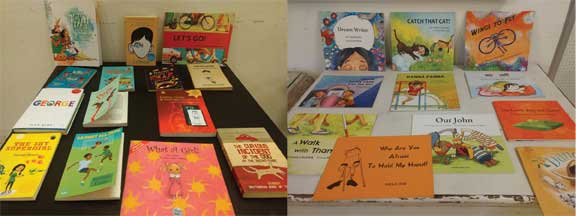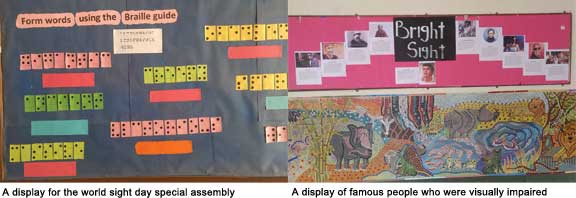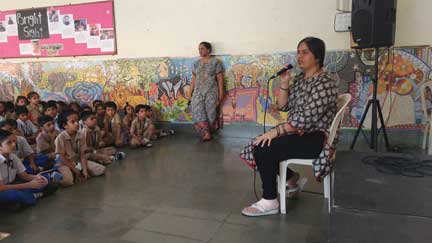Timira
This column will bring you stories of successful inclusive practices from schools, educators, and children. These stories hope to inspire and convince more schools that an inclusive education is not only possible but also imperative to build a sensitive and empathetic world around us.
I’d like to begin this month’s column by asking a question.
How many of you have had at least one incident in your life when you came in contact or had to interact with a person with disability and you were struck with awkwardness? Have you tried helping a visually impaired person cross a street and had no idea how to lead/hold the person? Have you caught yourself staring in amazement at individuals talking to each other in sign language? Or stolen glances at a child strapped to a wheelchair making, what seems like, wailing sounds? I once had three children with Down’s Syndrome join a workshop I was conducting and a volunteer asked me, with much unease, whether the three of them were siblings because they looked alike.
The oddity and awkwardness around disability among able individuals, because of sheer ignorance and lack of exposure, always strikes me as something gravely overlooked and unheeded by society. This is probably why the world we have built is designed exclusively for able individuals. Our streets, footpaths, railway stations, public transport and even our living spaces are not designed to allow people with disability to navigate – which is why we don’t see them or don’t talk about these shortcomings in our everyday design.
My frustration about this persistent ignorance probably comes from a very personal space, where I grew up with a cousin who had cerebral palsy and no one ever bothered to explain to me why a girl, just like me, did not grow up the way I did, and was unable to run around, eat by herself or communicate in words. We need to talk to our children, so they grow up with an inclusive understanding of our world that is made up of different people with different abilities who must all share and cherish what the world has to offer.
Here are a few thoughts that will help us build an inclusive society and enable us to have conversations with our children about disability, being differently abled and being inclusive.

Never too young to talk
We can have conversations with children as young as 2.5-3 years old. I remember having a simple conversation with my 3-year-old nephew about a visually impaired person when he saw a man walking down a promenade using a white stick. “He does not have eyes, so he cannot see,” is all I had to say for him to embark on a journey of many more questions, all of which were patiently answered.
As adults, we must find opportunities in the world around us to enable these conversations. These opportunities can spring up while walking down a street, in a market, watching television, looking at an image in a newspaper, teaching a topic in the classroom, and of course through stories and books.
Books as enablers for conversation
There are plenty of Indian and international children’s books that directly address disability and other ‘difficult’ issues. Books for teenagers and young adults like Wonder, A Curious Case of the Dog in the Nighttime, Flyaway Boy, Unbroken; chapter books for younger readers like Simply Nanju, Manya Learns to Roar, Against all Odds, Kittu’s Very Mad Day; a number of Hole Books by Duckbill and picture books for our youngest children like Neel on Wheels, A Walk with Thambi, Welcome to the Forest, Wings to Fly, Vibhuti Cat are some such books to name a few.
Additionally, there are also several picture books that may not directly address disability as a theme but through their illustrations, sensitively and skillfully, normalize it in everyday life, which is liberating and the perfect way to make inclusion seem possible and real. Let’s Go, Abba’s Day, Nani’s Walk to the Park, Dreamwriter and Catch that Cat are a few titles which include children on wheelchairs, visually impaired characters, children going through cancer treatment, each of them doing things such as pulling silly faces, studying in school, building sandcastles, and going shopping, as any child would.

Using academic topics as opportunities to talk
As educators, it is essential for us to constantly revisit the content we are delivering in our classrooms and shape it to fit the ever-changing world around us. While we have managed to add everything from robotics to coding into our curriculum, the idea of building social-emotional capacities in our children and welcome the attitude of inclusivity – aspects of life that are as essential – are often left untouched in the rigmarole of ‘completing the syllabus’. So, why not bring it into the syllabus?
We teach children ‘Body Parts’ and ‘5 Senses’ in their primary years of learning. We must use this as an opportunity to talk about the absence of certain body parts and senses and how individuals learn to live and function in the world without them. This becomes a great opportunity to bring in picture books, such as those mentioned above, into the classroom. A simple activity which requires one child to be blindfolded and taken around the school premises by another child, experiencing the space through other senses, not only builds sensorial development but also a sense of heightened empathy and sensitivity.

As students grow older, they keep learning about the body in further detail – the brain, the eye, the nervous system, etc., and each of these topics allows us an opportunity to delve into ‘non-academic’ aspects of learning. Another taboo topic that isn’t spoken about is adoption, and adopted children are often made to feel excluded. A wonderful way to introduce the idea of adoption is when learning the reproduction system. To learn from a young age that there are two ways of having children, one is biological and the other is through adoption can be a very healthy way to normalize this idea and move it away from being a ‘hush-hush’ topic.
Special assemblies
We have several World Awareness Days like World Autism Awareness Day, International Day of Persons with Disability, World Sight Day, and these can be used as an occasion to organize special assemblies, inviting individuals to share their world with teachers and children. Education must find ways to bring the outside world into the classroom, this is imperative.

Walk the talk
The Right to Free and Compulsory Education (RTE) Act 2009 mandates free and compulsory elementary education to all children including children with special needs. This is a fundamental right in our country and schools must take this on as a responsibility to ensure they work towards creating inclusive spaces. It isn’t easy and requires relooking infrastructure, curriculum, teacher capacities, assessment modules and several other aspects of sensitizing and awareness building.
However, the real experience of what it is to befriend a person with disability, to care for them, to ensure they feel safe and included in every aspect is urgent. It is the only way we can hope to create an empathetic and sensitive generation so that tomorrow’s engineers, product designers and policy makers finally start designing a world that is created for all.
The author is an arts-based therapist, educator and children’s author. She has been working with children from different backgrounds for the past 15 years and is an advocate of ‘inclusive education’. She is currently the Executive Director of an inclusive not-for-profit ICSE school in Mumbai. She can be reached at timira@gmail.com.
